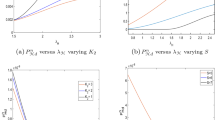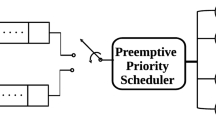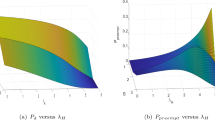Abstract
With the emergence of the internet and cellular networks, interest in using computer communication networks and communication systems has skyrocketed. However, unusual occurrences, like cyber attacks, power outages, network congestion, equipment failures, etc. lead to abrupt changes in the state of the system and pose a significant risk to these systems. Consequently, some/all users can be promptly eliminated from the system. These type of scenarios can be well modeled by the multi-server catastrophic queueing model (MSCQ). This article elaborates a MSCQ with the consideration of retrial phenomenon and preemptive repeat priority (PRP) scheduling. For brevity, the working of system before and after the catastrophe phenomenon is referred to as the normal and catastrophic environment, respectively. This study identifies the incoming traffic as calls which are further categorized on the basis of the model operation scenarios. In normal operation scenario, the calls are classified as handoff (\(\mathcal{H}\mathcal{C}\)) and new calls (\(\mathcal{N}\mathcal{C}\)). This study provides priority to \(\mathcal{H}\mathcal{C}\) over \(\mathcal{N}\mathcal{C}\) using PRP. Whereas, in the catastrophic environment, when the calamity strikes, the whole system is rendered inoperable, and all types of busy/waiting calls are flushed out. To reinstate services in the concerned region, a set of backup/standby channels are quickly deployed. In response to the emergency circumstances in the area, the calls made to emergency personnel are referred as emergency calls (\(\mathcal{E}\mathcal{C}\)). Hence, in this case, the incoming calls are categorized as \(\mathcal{H}\mathcal{C}\), \(\mathcal{N}\mathcal{C}\), and \(\mathcal{E}\mathcal{C}\). The \(\mathcal{E}\mathcal{C}\) are given priority using PRP over \(\mathcal{N}\mathcal{C}\)/\(\mathcal{H}\mathcal{C}\) due to the pressing need to save lives in such crucial situations. The system is modeled by a multi-dimensional Markov chain and by demonstrating that the Markov chain satisfies the requirements for asymptotically quasi-Toeplitz Markov chains, the chain’s ergodicity conditions are established. Furthermore, a non-dominated sorting genetic algorithm-II method has been employed to define and address an optimization problem to achieve the optimal number of resources.







Similar content being viewed by others
References
Ammar, S. I., & Rajadurai, P. (2019). Performance analysis of preemptive priority retrial queueing system with disaster under working breakdown services. Symmetry, 11(3), 419–434.
Artalejo, J. R., & Gomez-Corral, A. (2007). Modelling communication systems with phase type service and retrial times. IEEE Communications Letters, 11(12), 955–957.
Avin, S., Wintle, B. C., Weitzdörfer, J., hÉigeartaigh, Ó., Sutherland, S. S., & Rees, M. J. (2018). Classifying global catastrophic risks. Futures, 102, 20–26.
Ayyappan, G., & Thilagavathy, K. (2021). Analysis of MAP (1), MAP (2)/PH/1 non-preemptive priority queueing model under classical retrial policy with breakdown, repair, discouragement, single vacation, standby server, negative arrival and impatient customers. International Journal of Applied and Computational Mathematics, 7(5), 184.
Ayyappan, G., & Somasundaram, B. (2019). Analysis of two stage \(M [X_1], M[X_2]/G_1, G_2/1\) retrial G-queue with discretionary priority services, working breakdown, Bernoulli vacation, preferred and impatient units. Applications and Applied Mathematics: An International Journal, 14(2), 2.
Baumann, H., & Sandmann, W. (2012). Steady state analysis of level dependent quasi-birth-and-death processes with catastrophes. Computers & Operations Research, 39(2), 413–423.
Brandwajn, A., & Begin, T. (2017). Multi-server preemptive priority queue with general arrivals and service times. Performance Evaluation, 115, 150–164.
Chakravarthy, S. R. (2017). A catastrophic queueing model with delayed action. Applied Mathematical Modelling, 46, 631–649.
Chakravarthy, S. R., Dudin, A. N., & Klimenok, V. I. (2010). A retrial queueing model with map arrivals, catastrophic failures with repairs, and customer impatience. Asia-Pacific Journal of Operational Research, 27(06), 727–752.
Chakravarthy, S. R. (2020). A retrial queueing model with thresholds and phase type retrial times. Journal of Applied Mathematics & Informatics, 3–4, 351.
Chang, W. (1965). Preemptive priority queues. Operations Research, 13(5), 820–827.
Dabrowski, C. (2015). Catastrophic event phenomena in communication networks: A survey. Computer Science Review, 18, 10–45.
Dayar, T. (2012). Analyzing Markov chains using Kronecker products: Theory and applications. Springer.
Deb, K., Pratap, A., Agarwal, S., & Meyarivan, T. A. M. T. (2002). A fast and elitist multiobjective genetic algorithm: NSGA-II. IEEE Transactions on Evolutionary Computation, 6(2), 182–197.
Dharmaraja, S., Jindal, V., & Alfa, A. S. (2008). Phase-type models for cellular networks supporting voice, video and data traffic. Mathematical and Computer Modelling, 47(11–12), 1167–1180.
Dudin, A., Kim, C., Dudin, S., & Dudina, O. (2016). Analysis and optimization of Guard Channel Policy with buffering in cellular mobile networks. Computer Networks, 107, 258–269.
Dudin, S., & Dudina, O. (2019). Retrial multi-server queuing system with PHF service time distribution as a model of a channel with unreliable transmission of information. Applied Mathematical Modelling, 65, 676–695.
GnanaSekar, M. M. N., & Kandaiyan, I. (2022). Analysis of an \(M/G/1\) retrial queue with delayed repair and feedback under working vacation policy with impatient customers. Symmetry, 14(10), 2024.
He, Q. M. (2014). Fundamentals of matrix-analytic methods (Vol. 365). Springer.
He, Q. M., & Alfa, A. S. (2018). Space reduction for a class of multidimensional Markov chains: A summary and some applications. INFORMS Journal on Computing, 30(1), 1–10.
Jain, V., Raj, R., & Dharmaraja, S. (2021). Numerical optimization of loss system with retrial phenomenon in cellular networks. International Journal of Operatinal Research (In Press).
Jain, V., Raj, R., & Dharmaraja, S. (2022). Performability analysis of a \(M M A P [2]/P H[2]/S\) model with \(P H\) retrial times. Communication in Statistics Theory and Methods (In Press).
Kim, C., Dudin, S., Taramin, O., & Baek, J. (2013). Queueing system \(MAP/ PH/ N/ N+ R\) with impatient heterogeneous customers as a model of call center. Applied Mathematical Modelling, 37(3), 958–976.
Kim, J., & Kim, B. (2016). A survey of retrial queueing systems. Annals of Operations Research, 247(1), 3–36.
Kishorbhai, V. Y., & Vasantbhai, N. N. (2017). AON: A survey on emergency communication systems during a catastrophic disaster. Procedia Computer Science, 115, 838–845.
Klimenok, V., & Dudin, A. (2006). Multi-dimensional asymptotically quasi-Toeplitz Markov chains and their application in queueing theory. Queueing Systems, 54(4), 245–259.
Krishnamoorthy, A., Babu, S., & Narayanan, V. C. (2008). MAP/(PH/PH)/c queue with self-generation of priorities and non-preemptive service. Stochastic Analysis and Applications, 26(6), 1250–1266.
Kumar, N., & Gupta, U. C. (2023). Analysis of BMAP/MSP/1 queue with MAP generated negative customers and disasters. Communications in Statistics-Theory and Methods, 52(12), 4283–4309.
Kumar, N., & Gupta, U. C. (2020). Analysis of batch Bernoulli process subject to discrete-time renewal generated binomial catastrophes. Annals of Operations Research, 287(1), 257–283.
Latouche, G., & Ramaswami, V. (1999). Introduction to matrix analytic methods in stochastic modeling. Society for Industrial and Applied Mathematics.
Liu, T. H., Hsu, H. Y., Ke, J. C., & Chang, F. M. (2023). Preemptive priority Markovian queue subject to server breakdown with imperfect coverage and working vacation interruption. Computation, 11(5), 89.
Machihara, F. (1995). A bridge between preemptive and non-preemptive queueing models. Performance Evaluation, 23(2), 93–106.
Manoj, B. S., & Baker, A. H. (2007). Communication challenges in emergency response. Communications of the ACM, 50(3), 51–53.
Raj, R., & Jain, V. (2023). Optimization of traffic control in \(MMAP[2]/PH[2]/S\) priority queueing model with \({PH}\) retrial times and preemptive repeat policy. Journal of Industrial and Management Optimization, 19(4), 2333–2353.
Shin, Y. W., & Moon, D. H. (2011). Approximation of M/M/c retrial queue with PH-retrial times. European Journal of Operational Research, 213(1), 205–209.
Sudhesh, R., Savitha, P., & Dharmaraja, S. (2017). Transient analysis of a two-heterogeneous servers queue with system disaster, server repair and customers’ impatience. Top, 25(1), 179–205.
Wang, J., Liu, B., & Li, J. (2008). Transient analysis of an M/G/1 retrial queue subject to disasters and server failures. European Journal of Operational Research, 189(3), 1118–1132.
Yajima, M., & Phung-Duc, T. (2019). A central limit theorem for a Markov-modulated infinite-server queue with batch Poisson arrivals and binomial catastrophes. Performance Evaluation, 129, 2–14.
Yechiali, U. (2007). Queues with system disasters and impatient customers when system is down. Queueing Systems, 56(3), 195–202.
Funding
The first author, Raina Raj is supported by a senior research fellowship (SRF) grant No.- 09/1131(0024)/2018-EMR-I from Council of Scientific and Industrial Research (CSIR), India.
Author information
Authors and Affiliations
Corresponding author
Ethics declarations
Conflict of interest
The authors declare that they have no known competing financial interests or personal relationships that could have appeared to influence the work reported in this paper.
Additional information
Publisher's Note
Springer Nature remains neutral with regard to jurisdictional claims in published maps and institutional affiliations.
A Generator matrix entries
A Generator matrix entries
1.1 A.1 Upper diagonal matrix entries
The entries of Equation (1) are given as follows
1.2 A.2 First column matrix entries
The entries of Equation (4) are given as follows
1.3 A.3 Lower diagonal matrix entries
The entries of Equation (7) are given as follows
1.4 A.4 Main diagonal matrix entries
The entries of Equations (12) and (13) are given as follows
Rights and permissions
Springer Nature or its licensor (e.g. a society or other partner) holds exclusive rights to this article under a publishing agreement with the author(s) or other rightsholder(s); author self-archiving of the accepted manuscript version of this article is solely governed by the terms of such publishing agreement and applicable law.
About this article
Cite this article
Raj, R., Jain, V. Resource and traffic control optimization in MMAP[c]/PH[c]/S queueing system with PH retrial times and catastrophe phenomenon. Telecommun Syst 84, 341–362 (2023). https://doi.org/10.1007/s11235-023-01053-x
Accepted:
Published:
Issue Date:
DOI: https://doi.org/10.1007/s11235-023-01053-x




